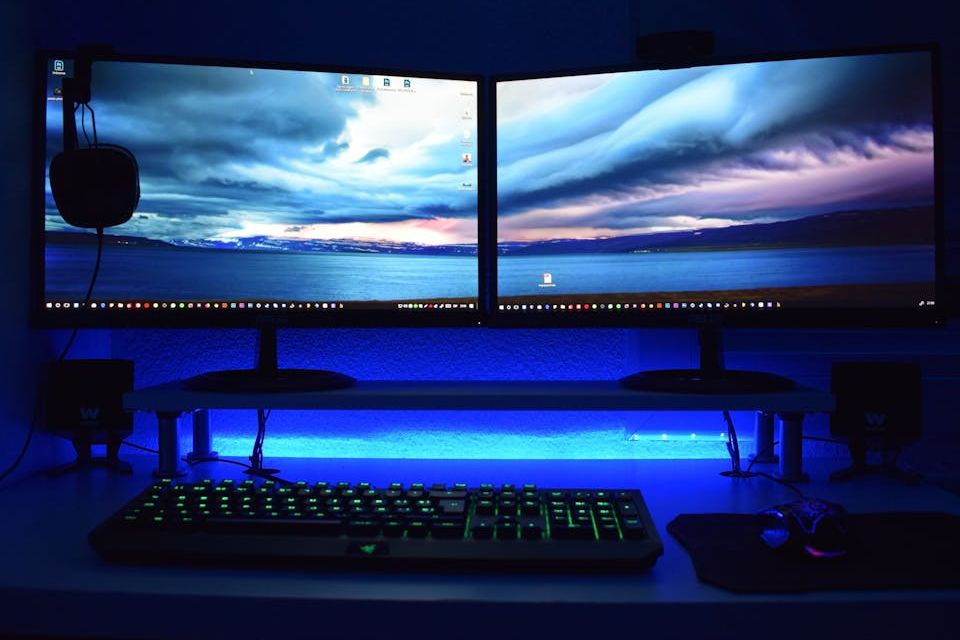This article dives deep into the world of display technology, comparing and contrasting IPS LCD and AMOLED displays. We'll explore the inner workings of each display, their strengths and weaknesses, and ultimately help you understand which display display technologies is right for your needs. Whether you're choosing a new smartphone, tablet, or monitor, this comprehensive guide will equip you with the knowledge to make an informed decision in the battle of AMOLED vs LCD.
To truly understand the IPS vs AMOLED debate, it's crucial to first grasp the fundamental principles behind each display technology. Both IPS LCDs and AMOLED displays are widely used in a variety of devices, from smartphones to TVs, but they employ drastically different methods to create the images you see.
LCD stands for liquid crystal display. LCD technology has been around for a long time and relies on liquid crystal molecules to modulate light. These crystals don't emit light themselves; instead, they act as shutters, controlling how much light passes through them. The light source, known as the backlight, is located behind the liquid crystal layer. IPS, or In-Plane Switching, is a specific type of LCD technology that offers improved viewing angles and color accuracy compared to earlier LCD designs.
AMOLED, on the other hand, stands for active matrix organic light emitting diode. AMOLED displays are a subset of OLED display technology, which utilizes organic compounds that emit light when an electric current is applied. Unlike LCDs, AMOLED displays do not require a backlight; each pixel is its own light source. The "active matrix" part refers to the electronic circuit behind the organic light emitting diode pixel that controls each individual pixel. This fundamental difference in how they generate light has a significant impact on their performance characteristics.

LCDs, particularly IPS LCDs, work through a clever combination of liquid crystals, polarizers, and a backlight. The backlight is a crucial component, providing the necessary illumination for the whole display to be visible. This backlight to illuminate the LCD screen can be achieved using leds, fluorescent lamps, or other light sources.
The light from the backlight passes through a polarizer, which filters the light waves so they vibrate in a single direction. This polarized light then travels through the liquid crystal layer. The liquid crystals are arranged in tiny cells, and their orientation can be controlled by applying an electric current. By varying the electric current, the liquid crystals twist to varying degrees, altering the polarization of the light passing through them.
The light then encounters a second polarizer, oriented perpendicularly to the first. Depending on the degree of polarization shift caused by the liquid crystals, varying amounts of light are allowed to pass through the second polarizer. This process controls the brightness of each pixel, ultimately creating the image you see on the display. IPS technology enhances this process by aligning the liquid crystals in a way that provides better off-axis viewing angles and more accurate color reproduction compared to its lcd counterparts.
AMOLED displays, short for active matrix organic light emitting diodes, represent a significant departure from LCD technology in how they generate light. Unlike LCDs, which rely on a backlight to illuminate the screen, AMOLED displays are self-emissive. This means that each individual pixel within an AMOLED screen generates its own light.
The heart of an pixel in an amoled display is an organic light emitting diode. These oled technology diodes are made from thin films of organic light emitting diode compounds that emit light when an electric current is passed through them. The color of the light emitted depends on the specific organic light emitting diode material used. Red, green, and blue organic light emitting diodes are used to create the full spectrum of colors through a process called additive color mixing.
The "active matrix" component refers to the thin-film transistor (TFT) active matrix circuit that controls each individual pixel. This active matrix allows for precise control over the electric current flowing through each organic light emitting diode, enabling AMOLED displays to achieve high contrast ratios, vibrant colors, and true blacks. Because the amoled screens can turn off individual pixels completely, they can achieve deep blacks and excellent contrast ratios, something that IPS LCDs, with their always-on backlight, struggle to match. AMOLED display makes smartphones and wearable devices visually stunning.
The amoled vs lcd comparison is complex, with each technology excelling in different areas. To make an informed decision, it's important to understand how they stack up in terms of key performance metrics:
Super AMOLED is a type of oled display technology developed and marketed by Samsung. It's essentially an enhanced version of AMOLED display technology, designed to offer improved performance and visual quality. The key difference lies in the integration of the touch sensor directly into the display panel. In traditional AMOLED displays, the touch sensor is a separate layer placed on top of the display.
By integrating the touch sensor into the display itself, Super AMOLED super amoled displays achieves several advantages:
While other manufacturers use variations of AMOLED display technology, Samsung's Super AMOLED remains a benchmark for smartphones amoled in terms of display quality and touch performance.

The perception that AMOLED always offers better color accuracy than IPS LCD is a common misconception. While amoled displays light produces vibrant and saturated colors, this doesn't necessarily translate to greater accuracy. In fact, ips displays tend to be more color accurate out of the box.
AMOLED displays often target a wider color gamut, such as DCI-P3, which allows them to display a broader range of colors than IPS LCDs. However, this wider gamut can sometimes lead to oversaturation, where colors appear more vivid than they should, making them less accurate to the source material. LCDs displays, particularly IPS panels, are often calibrated to the sRGB color space, which is the standard for web content and many other applications. This calibration typically results in more neutral and accurate color reproduction.
However, it's important to note that both IPS LCD and AMOLED displays can be calibrated to achieve excellent color accuracy. High-end IPS monitors are often factory-calibrated to meet strict color accuracy standards, and many smartphones with AMOLED screens offer different color modes that allow users to choose between vibrant, saturated colors and more accurate, neutral colors. Ultimately, whether an ips display vs amoled has better performance will depend on the specific display, its calibration, and the user's preferences.
Power consumption is a crucial factor to consider when choosing between IPS LCD and AMOLED displays, particularly for devices like smartphones. In general, AMOLED displays are considered more power efficient in certain scenarios, while IPS LCDs can be more power efficient in others.
The key difference lies in how each technology generates light. AMOLED screens save power by turning off individual pixels completely when displaying black. This means that when displaying dark images or interfaces with black backgrounds, AMOLED displays consume significantly less power than IPS LCDs, which must illuminate the backlight for the whole display, regardless of the content being shown. For static images an amoled display offers power efficiency by using less power compared to ips.
However, when displaying bright images or content with a lot of white, AMOLED power consumption can actually be higher than ips lcd. This is because AMOLED displays need to drive all of those individual pixels to full brightness, which consumes a significant amount of electric current. In contrast, IPS LCDs can efficiently illuminate the backlight to achieve high brightness levels across the entire screen. In summary, the better battery life ips or amoled depends heavily on the content being displayed.

The question of whether AMOLED vs LCD is better for eyes is complex and depends on several factors, including individual sensitivity, display settings, and usage habits. There's no definitive answer, but here's a breakdown of the key considerations:
One of the historical concerns surrounding AMOLED displays has been the issue of screen burn-in, also known as image persistence. Screen burn-in occurs when a static image is displayed on the screen for an extended period, causing the organic light emitting diode compounds in those areas to degrade faster than others. This can result in a ghost image of the static element being permanently visible on the screen.
IPS LCDs, on the other hand, are not susceptible to screen burn-in because they don't rely on organic light emitting diode materials that degrade over time. However, LCDs can experience image retention, where a ghost image appears temporarily after a static image has been displayed for a long time. This image retention is usually temporary and disappears after a short period of use.
While screen burn-in was a significant concern in early AMOLED displays, advancements in technology have greatly reduced the risk. Modern AMOLED displays use improved organic light emitting diode materials and algorithms that help to mitigate screen burn-in. These algorithms include pixel shifting, which subtly moves the image on the screen to prevent static elements from being displayed in the same location for too long, and brightness compensation, which adjusts the brightness of individual pixels to even out wear. The flexibility of amoled makes amoled and ips and amoled different type of display technology.
The future of display technology is constantly evolving, with both IPS LCD and AMOLED displays undergoing continuous improvements and innovations. While it's impossible to predict the future with certainty, here are some key trends and potential developments to watch for ips lcd and amoled displays:
Table 1: Key Differences Between IPS LCD and AMOLED Displays
| Feature | IPS LCD | AMOLED |
|---|---|---|
| Light Source | Backlight | Self-Emitting pixels |
| Contrast Ratio | Lower | Higher |
| Color Accuracy | Generally More Accurate Out-of-Box | Can be Oversaturated |
| Brightness | Higher Peak Brightness | Improving |
| Viewing Angle | Excellent | Excellent, but some color shift possible |
| Power Consumption | Higher in Dark Scenes | Lower in Dark Scenes |
| Screen Burn-In | Not Susceptible | Potential Risk (Mitigated in Modern displays) |
Table 2: Potential Future Developments in Display Technology
| Technology | Key Features | Potential Benefits |
|---|---|---|
| MicroLED | Microscopic LEDs for image creation | High brightness, excellent contrast ratio, wide color gamut, long lifespan |
| Quantum Dot | Nanoscale crystals that emit light | Enhanced color performance in both LCD and AMOLED displays |
| Foldable/Rollable | Flexible AMOLED displays | Innovative device form factors, larger screens in smaller packages |
| Power Efficiency | New materials and technologies to reduce power consumption | Longer battery life in portable devices |
Contact: David
Phone: +8618665976986
Tel: +8675521563288
Email: [email protected]
Add: 305 Room A Buiding Huafeng International Robot Industrial Park Xixiang Bao'an